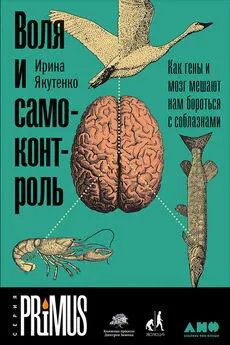Рейчел Херц - Почему мы едим то, что едим [Наука о том, как наш мозг диктует нам, что есть]
- Название:Почему мы едим то, что едим [Наука о том, как наш мозг диктует нам, что есть]
- Автор:
- Жанр:
- Издательство:Литагент 5 редакция
- Год:2021
- Город:Москва
- ISBN:978-5-04-097490-0
- Рейтинг:
- Избранное:Добавить в избранное
-
Отзывы:
-
Ваша оценка:
Рейчел Херц - Почему мы едим то, что едим [Наука о том, как наш мозг диктует нам, что есть] краткое содержание
Какие музыкальные жанры лучше всего подчеркивают вкус красного вина? Почему нам хочется калорийной пищи, когда нас постигают неудачи? Как наша личность соотносится с предпочтением сладкого или соленого?
Эта книга, словно чуткий проводник, помогает читателю уловить и распознать сенсорные, психологические и физиологические факторы, лежащие в основе пищевых привычек. С этим знанием вы сможете сделать каждый прием пищи осознанным и здоровым, а также получать только удовольствие от еды.
Почему мы едим то, что едим [Наука о том, как наш мозг диктует нам, что есть] - читать онлайн бесплатно ознакомительный отрывок
Интервал:
Закладка:
31. M. Iacoboni, «Imitation, empathy, and mirror neurons», Annual Review of Psychology 60 (2009): 653–670.
32. M. Shimizu, K. Johnson, and B. Wansink, «In good company: The effect of an eating companion’s appearance on food intake», Appetite 83 (2014): 263–268.
33. Roth et al., «Self-presentational conflict in social eating situations».
ПРИМЕЧАНИЯ К СТР. 203–216
34. A. B. Lee and M. Goldman, «Effect of staring on normal and overweight students», Journal of Social Psychology 108 (1979): 165–169.
ГЛАВА 8. ВЫ ВСЕ ЕЩЕ СЫТЫ?
1. S. H. A. Holt et al., «A satiety index of common foods», European Journal of Clinical Nutrition 49 (1995): 675–690.
2. D. Mozaffarian et al., «Changes in diet and lifestyle and longterm weight gain in women and men», New England Journal of Medicine 364 (2011): 2392–2404.
3. J. M. Brunstrom, N. G. Shakeshaft, and N. E. Scott-Samuel, «Measuring ‘expected satiety’ in a range of common foods using a method of constant stimuli», Appetite 51 (2008): 604–614.
4. A. Farmer et al., «Neuroticism, extraversion, life events and depression: The Cardiff Depression Study», British Journal of Psychiatry 181 (2002): 118–122.
5. «Correlation», adapted (адаптировано) from David W. Stockburger, «Introductory Statistics: Concepts, Models, and Applications», http://www2.webster.edu/~woolflm/corre-lation/correlation.html.
6. Brunstrom, Shakeshaft, and Scott-Samuel, «Measuring ‘expected satiety’».
7. K. D. Vohs et al., «Rituals enhance consumption», Psychological Science 24 (2013): 1714–1721.
8. M. I. Norton, D. Mochon, and D. Ariely, «The IKEA effect: When labor leads to love», Journal of Consumer Psychology 22 (2012): 453–460.
9. S. Dohle, S. Rail, and M. Siegrist, «I cooked it myself: Preparing Food increases liking and consumption», Food Quality and Preference 33 (2014): 14–16.
10. Norton, Mochon, and Ariely, «The IKEA effect».
11. «Overview of FDA Labeling Requirements for Restaurants, Similar Retail Food Establishments and Vending Machines», U.S. Food and Drug Administration, http://www.fda.gov/Food/ IngredientsPackagingLabeling/LabelingNutrition/ucm248732.htm.
12. L. Thach, «Time for wine? Identifying differences in wine-drinking occasions for male and female wine consumers», Journal of Wine Research 23 (2012): 134–154.
ПРИМЕЧАНИЯ К СТР. 217–222
13. Kenneth Chang, «Artificial Sweeteners May Disrupt Body’s Blood Sugar Controls», New York Times «Well» blog, September 17, 2014, http://well.blogs.nytimes.com/2014/09/17/artificial-sweete-ners-may-disrupt-bodys-blood-sugar-controls; Dr. Mercola, «How Artificial Sweeteners Confuse Your Body into Storing Fat and Inducing Diabetes», Mercola website, December 23, 2014, http://articles.mercola.com/sites/articles/archive/2014/ 12/23/artificial-sweeteners-confuse-body.aspx.
14. Dan Charles, «In The Search For The Perfect Sugar Substitute, Another Candidate Emerges», The Salt, NPR, August 25, 2015, http://www.npr.org/sections/the salt/2015/08/ 25/434597445/in-the-hunt-for-the-perfect-sugar-substitute-an-other-candidate-emerges.
15. L. Cordain et al., «Influence of moderate daily wine consumption on body weight regulation and metabolism in healthy free-living males», Journal of the American College of Nutrition 16 (1997): 134–139.
16. P. M. Suter and A. Tremblay, «Is alcohol consumption a risk factor for weight gain and obesity?» Critical Reviews in Clinical Laboratory Sciences 42 (2005): 197–227.
17. C. S. Lieber, «Perspectives: Do гОсоНо! calories count?» American Journal of Clinical Nutrition 54 (1991): 976–982; Suter and Tremblay, «Is alcohol consumption a risk factor for weight gain and obesity?»
18. Suter and Tremblay, «Is alcohol consumption a risk factor for weight gain and obesity?»
19. «Questions and Answers on the Menu and Vending Machines Nutrition Labeling Requirements», U.S. Food and Drug Administration, http://www.fda.gov/Food/IngredientsPackaging Labeling/Labeling Nutrition/ucm248731.htm.
20. «Binge Eating Disorder», National Eating Disorders Association website, https://www.nationaleatingdisorders.org/binge-eating-disoder.
21. M. Cabanac, «Physiological role of pleasure», Science 173 (1971): 1103–1107.
22. B. J. Rolls, E. A. Rowe, and E. T. Rolls, «How sensory properties of foods affect human feeding behavior», Physiology and Behavior 29 (1982): 409–417.
23. M. M. Hetherington and B. J. Rolls, «Sensory-specific satiety: Theoretical frameworks and central characteristics», in E. D. Capaldi, ed., Why We Eat What We Eat: The Psychology of Eating (Washington DC: American Psychological Association, 1996), 267–290.
ПРИМЕЧАНИЯ К СТР. 223–234
24. M. Hetherington and B. J. Rolls, «Sensory specific satiety and food intake in eating disorders», in B. T. Walsh, ed., Eating Behavior in Eating Disorders (Washington, DC: American Psychiatric Press, 1988), 141–160.
25. B. J. Rolls et al., «Variety in a meal enhances food intake in man», Physiology and Behavior 26 (1981): 215–221; Rolls et al., «How sensory properties of foods affect human feeding behavior».
26. B. J. Rolls and T. M. McDermott, «Effects of age on sensory-specific satiety», American Journal of Clinical Nutrition 54 (1991): 988–996.
27. R. C. Havermans, J. Hermanns, and A. Jansen, «Eating without a nose: Olfactory dysfunction and sensory-specific satiety». Chemical Senses 35 (2010), 735–741.
28. E. T. Rolls and A. W. L. de Waal, «Long-term sensory-specific satiety: Evidence from an Ethiopian refugee camp», Physiology and Behavior 34 (1985): 1017–1020.
29. C. K. Morewedge, Y. E. Huh, and J. Vosgerau, «Thought for food: Imagined consumption reduces actual consumption», Science 303 (2010): 1530–1533.
30. J. Larson, J. P. Redden, and R. Elder, «Satiation from sensory simulation: Evaluating foods decreases enjoyment of similar foods», Journal of Consumer Psychology 24 (2013): 188–194.
31. Oscar Wilde, «The Picture of Dorian Gray», Lippincott’s Monthly Magazine, July 1890.
1. Oriana Schwindt, «Election Night Ratings: More than 71 Million TV Viewers Watched Trump Win». Variety, November 9, 2016, http://variety.com/2016/tv/news/election-night-ratings-donald-trump-audience-1201913855.
2. Virginia Chamlee, «On Election Night, Americans Self-Medicated With Delivery Food and Booze», Eater, November 14, 2016, http://www.eater.com/2016/11/14/13621652/election-night-food-postmates-grubhub.
3. Maria Lamagna, «Here Are the Comfort Foods America Binged on as the Election Unfolded», MarketWatch, November 16, 2016, http://www.marketwatch.com/story/this-is-what-americans-ate-on-election-day-and-after-2016-11-11.
ПРИМЕЧАНИЯ К СТР. 234–240
4. A. Pearlman, Smart Casual: The Transformation of Gourmet Restaurant Style in America (Chicago: University of Chicago Press, 2013, 182.
5. B. Wansink, M. M. Cheney, and N. Chan, «Exploring comfort food preferences across age and gender», Physiology and Behavior 79 (2003): 739–747.
6. Corsica, Joyce A., and Bonnie J. Spring. «Carbohydrate craving: A double-blind, placebo-controlled test of the self-medication hypothesis». Eating Behaviors 9 (2008): 447–454.
7. J. E. Gangwisch et al., «High glycemic index diet as a risk factor for depression: Analyses from the Women’s Health Initiative», American Journal of Clinical Nutrition 102 (2015): 454–463.
8. «Global Chocolate Market worth $98.3 billion by2016», MarketsandMarkets, http://www.marketsandmarkets.com/PressReleases/ global-chocolate-market-asp.
9. Crystal Lindell, «Mintel: U.S. Chocolate market to hit $25B in 2019», Candy Industry, April 1, 2015, http://www.can-dyindustry.com/articles/86698-mintel-us-chocolate-market-to-hit-25b-in-2019.
10. «The Chocolate League Tables 2014: Top 2 °Consuming Nations», Target Map, http://www.targetmap.com/viewer.aspx-?reportId-38038; см. также Jon Marino, «Prescription-Strength Chocolate», Science News, February 10, 2004, http://www.ca-cao-chocolate.com/health/chocprescribe.html.
11. G. E. Crichton, M. F. Elias, and A. A. Alkerwi, «Chocolate intake is associated with better cognitive function: The Maine-Syracuse Longitudinal Study», Appetite 100 (2016): 126–132.
12. Личное общение, Adam Drewnowski, January 27, 2009.
13. A. Drewnowski et al., «Naloxone, an opiate blocker, reduces the consumption of sweet high-fat foods in obese and lean female binge eaters», American Journal of Clinical Nutrition 61 (1995): 1206–1212.
14. M. Macht and J. Mueller, «Immediate effects of chocolate on experimentally induced mood states». Appetite 49 (2007): 667–674.
15. L. E. Williams and J. A. Bargh, «Experiencing physical warmth promotes interpersonal warmth», Science 322 (2008): 606–607.
16. J. D. Troisi and S. Gabriel, «Chicken soup really is good for the soul: ‘Comfort food’ fulfills the need to belong», Psychological Science 22 (2011): 747–753.
ПРИМЕЧАНИЯ К СТР. 240–249
17. Пример «надежного» типа привязанности. Я легко обретаю эмоциональную связь с людьми. Не испытываю проблем, если завишу от других или другие зависят от меня. Не боюсь одиночества и не переживаю, когда меня отвергают другие. Пример «ненадежного» типа привязанности. Я не отличаюсь особой общительностью. Я хотел бы эмоционально более близких отношений, но не доверяю людям или боюсь впасть в зависимость от них. Я переживаю, что сближение с людьми причинит мне страдания.
18. J. D. Troisi et al., «Threatened belonging and preference for comfort food among the securely attached», Appetite 90 (2015): 58–64.
19. C. A. Reid et al., «Scent-evoked nostalgia», Memory 23 (2015): 157–166.
20. В исследовании участвовали 602 женщины и 401 мужчина; Wansink, Cheney, and Chan, «Exploring comfort food preferences across age and gender».
21. «Statistics and Facts on the National Football League (NFL)», Statista, http://www.statista.com/topics/963/national-football-league.
22. Kathleen Burke, «Guess How Many Chicken Wings Amc'ricans Will Consume During the Super Bowl?» MarketWatch, February 7, 2016, http://www.marketwatch.com/story/super-bowl-consumption-by-the-numbers-2016-01-29; «How many chicken wings are eaten per day in the US?» Answers, http://www.answers.com/Q/How_ many_chicken_wings_are_eaten_ per_day_in_the_US? – slide=2.
23. Y. Cornil and P. Chandon, «From fan to fat? Vicarious losing increases unhealthy eating, but self-affirmation is an effective remedy», Psychological Science 24 (2013): 1936–1946.
Читать дальшеИнтервал:
Закладка:
![Обложка книги Рейчел Херц - Почему мы едим то, что едим [Наука о том, как наш мозг диктует нам, что есть]](/books/1061252/rejchel-herc-pochemu-my-edim-to-chto-edim-nauka-o-t.webp)









